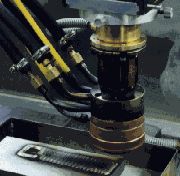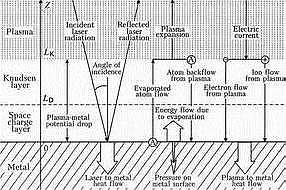|
|
Investigation
of Hybrid Processes of Metal Treatment and Development of Integrated Plasma Torches
for Laser+Plasma Arc Welding, Cutting and Surfacing
|
Sample
R&D Project
Open for collaboration!
|
The main purposes
of this project are: combining of the advantages of the known
methods of laser and plasma transferred arc treatment of metals and
widening of their possibilities within new hybrid processes of laser
+ plasma arc welding (LPAW), cutting (LPAC) and surfacing (LPAS).
The project provides:
theoretical investigations of the physical phenomena occurring at hybrid
processes of metal treatment, development of integrated laser-arc plasma
torches for LPAW, LPAC and LPAS, as well as their technological examinations.
The expected results
are: improving of efficiency and productivity of the laser
methods of metal treatment, as well as widening of metal thickness range
for the laser welding, cutting and surfacing without considerable degrading
of their quality and increasing of the laser power used.
Objectives:
- To investigate interaction of the focused
laser beam with the plasma transferred arc and their combined effect
on different metals as applied to LPAW, LPAC and LPAS of various materials,
including aluminium alloys.
- To develop the main principles of the
hybrid processes and concept of the integrated laser-arc plasma torches
for LPAW, LPAC and LPAS.
- To create the prototypes of integrated
plasma torches for laser + plasma welding and surfacing as applied
to the special technological processes.
- To carry out the experimental and technological
examinations of LPAW, LPAC and LPAS.
Brief
background:
Alongside with the conventional methods
of metal joining and treatment that use arc (plasma transferred arc),
laser or electron beam heating of metal, the hybrid technological processes
are increasingly developing. The essence of these processes is in the
simultaneous using of two different heat sources, for example, the laser
beam and the electric arc (see, e.g., V.S. Gvozdetsky, I.V. Krivtsun
et al., Laser-arc discharge: Theory and applications, Welding and Surfacing
Rev., Vol. 3, Harwood Academic Publishers, 1995).
In the realisation of the hybrid laser-arc processes for welding and
cutting the application of additional arc plasma heating of metal increases
the efficiency of the corresponding laser process. This is especially
important when low-power lasers are used. On the other hand, the usage
of the electric arc together with the laser beam improves the spatial
stabilisation of the arc root on the metal surface at low current and
high travel speed. It allows to increase greatly the stability and productivity
of the corresponding arc process.
The most rational scheme of the hybrid welding and surfacing processes
is the scheme, using plasma transferred arc with the introducing of
the laser beam along the axis of plasma-shaping channel of the plasma
torch. In contrast to the known methods of laser-arc welding and cutting,
this scheme ensures the required coaxial nature of the effect of the
laser beam and the electric arc on a workpiece. Moreover, this scheme
is characterised by new possibilities of mutual control of the characteristics
of the plasma arc and the laser beam, as sources of thermal and dynamic
effects on the surface of metal being treated.
The coaxial combination of the laser beam with the plasma arc requires
special devices to be developed - the integrated laser-arc plasma torches
(see, e.g., I.S. Dykhno, I.V. Krivtsun and G.N. Ignatchenko, Combined
laser and plasma arc welding torch.
Pat. No.5700989, USA, Int. Cl. B23K 26/00, 10/00, published 23.12.97),
the special feature of which is the electrode unit design, that enables
the laser beam to be introduced along the plasma-shaping channel. The
design peculiarities of such devices are determined by the parameters
of the laser beam used (CO2 or Nd-YAG laser, power range,
mode and focusing of the initial beam); the kind and flow rate of plasma
gas (Ar, He, or their mixtures, air, O2, or N2);
the current range and polarity of the plasma arc, as well as the kind
and thickness of the metal being treated.
Our team has great experience in the field of gas discharge physics
(arc, optical and combined laser-arc discharge), engineering of plasma
and integrated equipment for metal treatment, as well as its industrial
applications. To our mind, the hybrid laser + plasma technologies (LPAW,
LPAC, LPAS) present a new step in the development of material treatment
methods and their industrial applications are very important at this
time.
Program of the theoretical
investigations:
 Stage
I. Development of 1D model (one-dimensional, local model) of the
physical processes occurring in a system "laser radiation - near-surface
plasma - metal surface", as applied to laser and hybrid methods of metal
treatment: Stage
I. Development of 1D model (one-dimensional, local model) of the
physical processes occurring in a system "laser radiation - near-surface
plasma - metal surface", as applied to laser and hybrid methods of metal
treatment:
- Investigation of metal evaporation
into near-surface plasma (shielding or plasma gas at the atmospheric
pressure). Calculation of particle (mass) and energy flows from the
metal, pressure at its surface and temperature of heavy particles
in the plasma (with taking into account the reversed particle flow)
as functions of local values of the metal surface temperature and
Mach number outside Knudsen layer.
- Determination of the near-surface plasma
composition (ionisation-recombination processes with taking into account
one-dimensional mutual diffusion of shielding gas and metal vapor
particles), depending on the metal surface and plasma electron temperatures.
Calculation of thermodynamic characteristics (mass density, specific
heat), transport coefficients (viscosity, thermal and electrical conductivity)
and optical properties (plasma radiation losses, refractive index
and absorptivity of laser radiation) for this multi-component plasma.
- Investigation of laser radiation (CO2,
Nd-YAG - lasers) absorption and reflection by the metal surface (with
taking into account refraction and absorption of the laser radiation
in near-surface plasma). Calculation of laser heat flow into the metal
as a function of local values of the metal surface and plasma electron
temperatures, intensity, polarisation and angle of incidence of the
laser radiation.
- Investigation of energy balance of
the near-surface plasma (laser or combined plasma). Calculation of
plasma electron temperature (with taking into account one-dimensional
plasma expansion).
- Calculation of electric potential distribution
in the near-surface region and flows of particles and energy from
plasma to the metal surface as functions of local values of electric
current density in plasma and metal surface temperature.
- Determination of total energy balance
and pressure on the metal surface as functions of local values of
arc current density, incident laser radiation characteristics and
metal surface temperature.
Deliverables:
Local dependencies of the heat flow into
the metal and pressure at its surface on this surface temperature, laser
radiation characteristics, electric current density in the near-surface
plasma and its expansion velocity, as applied to laser and hybrid processes
of metal treatment.
Stage II.
Development of 2D computer models (two-dimensional, axisymmetrical models)
of the processes inside the near-surface plasma, on the surface and inside
the metal at laser and hybrid methods of metal treatment with the motionless
heat source:
- Development of computer model of the
near-surface laser plasma with axisymmetrical distributions of the
plasma and laser beam parameters (with taking into account laser plasma
expansion).
- Investigation of non-stationary thermal
processes inside the metal with preassigned boundary conditions on
its surface (with taking into account movement of the phase transition
boundaries).
- Investigation of the metal surface
and liquid metal dynamics with preassigned boundary conditions for
erosion and pressure on its surface (for given melting boundary geometry).
- Development of 2D computer model of
the cathode phenomena at hybrid processes (with taking into account
electron emission peculiarities, cathode spot mode and near-cathode
plasma expansion).
- Development of 2D computer model of
the anode phenomena at hybrid processes of metal treatment (with taking
into account arc current distribution inside the anode region and
near-anode plasma expansion).
- Complex simulation of non-stationary
thermal and dynamical processes inside the metal with self-consistent
boundary conditions on its surface at laser and hybrid methods of
metal treatment (for different arc polarity and motionless heat source).
Deliverables:
Self-consisted 2D computer models of non-stationary
metal penetration processes at laser and hybrid methods of metal treatment
with the motionless heat source. This models can be used for computer
estimation of the metal penetration dynamics, depending on the metal
thickness, initial laser beam characteristics (wave length, power, mode
and focusing conditions), arc current and its polarity, as well as the
time interval of their affecting on the metal.
Stage III.
Development of 2+3D computer models (two-dimensional, axisymmetrical near-surface
plasma model and three-dimensional model of thermal and dynamical processes
inside the workpiece) of metal penetration at laser and hybrid welding:
- Investigation of quasi-stationary thermal
processes inside the metal with preassigned boundary conditions on
its surface (with taking into account movement of axisymmetrical heat
source).
- Investigation of quasi-stationary dynamics
of the weld pool surface and liquid metal dynamics with preassigned
boundary conditions (axisymmetrical) for erosion and pressure on its
surface (for given melting boundary geometry).
- Determination of self-consisted boundary
conditions (axisymmetrical) on the weld pool surface as applied to
laser and hybrid processes.
- Complex computer simulation of metal
penetration at laser and hybrid welding of different metals.
Deliverables:
Self-consisted 2D, 3D computer models of
quasi-stationary metal penetration processes at laser and hybrid welding.
These models can be supplied by Windows friendly interface for future
commercial realisation of the developed software. This software can
be used for computer simulation of laser and hybrid welding of metals,
depending on the metal thickness, initial laser beam characteristics
(wave length, power, mode and focusing conditions), arc current and
its polarity, as well as the welding speed.
|